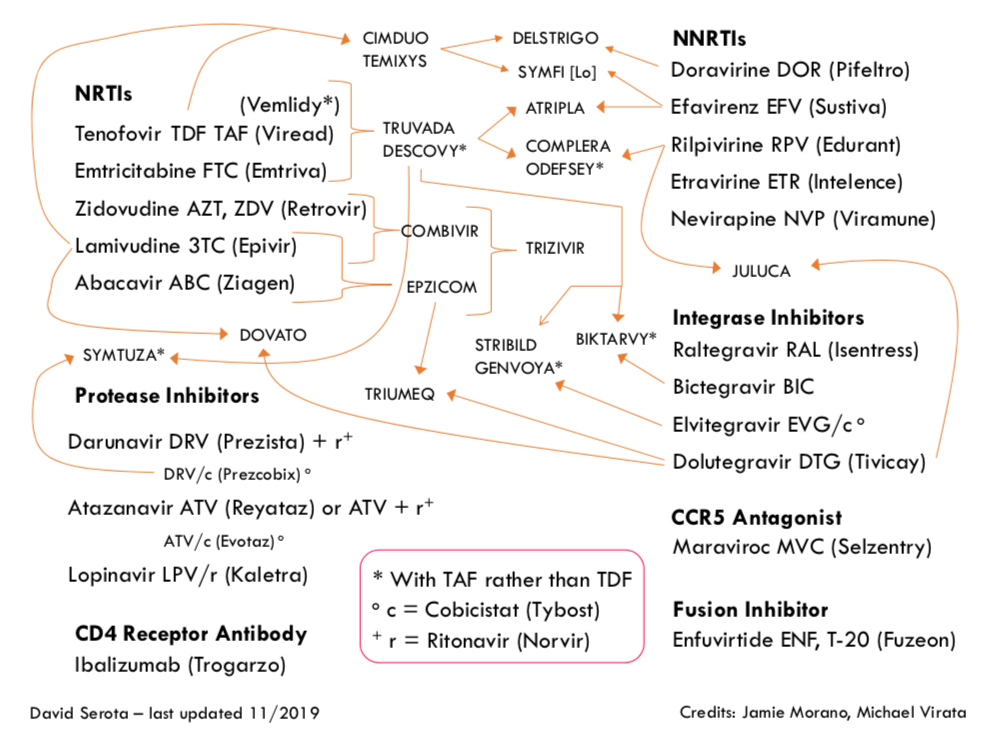An ongoing dialogue on HIV/AIDS, infectious diseases,
November 18th, 2019
The Best Guide to HIV Drug Names — Yours for Free!
Earlier this month, I noted something that all of us ID/HIV specialists should readily concede — namely, that learning the names of the HIV drugs is fiendishly difficult.
Afterwards, I heard from a few old-timers (that is, people like me). They acknowledged that we were lucky to experience the roll-out of these medications (and their convoluted names) in real time, which made learning them easier.
And some people currently struggling with the names wished for a logical code to the nomenclature, analogous to the HCV drugs. The HCV protease inhibitors, for example, all wrap up with -previr, e.g., telaprevir (may it R.I.P.) up to glecaprevir. And the NS5A inhibitors end with -asvir, e.g., velpatasvir and pibrentasvir.
By contrast, what do we get with HIV drugs? While all of the integrase inhibitors have -tegravir in their names — hooray! — the NRTIs, NNRTIs, and PIs are a mess.
Specifically — why do all the NNRTIs end with -ine (nevirapine, rilpivirine, doravirine) except efavirenz?
(Brief aside — efavirenz. What a bizarre word. No wonder it causes CNS toxicity.)
Plus, don’t many of the NRTIs end with -ine as well?
Of course they do (zidovudine through emtricitabine) — that is, until they don’t (abacavir). And this NRTI just happens to end with -avir, which is how all the HIV protease inhibitors end.
Bedlam!
To help the confused masses, some of you kindly sent along your “cheat sheets,” many of which were better than the one I posted. All of them shared the strategy of excluding drugs we no longer use, which simplifies things a lot.
This one, from Dr. Kristen Brown, was excellent — it even includes a few resistance pearls — useful! However, due to the complexity of resistance, this will need eternal tweaking (even this one), so Kristen says she might retire that section.
But, as she noted, there was another choice pick — and that was from Dr. David Serota (a.k.a. @serotavirus).
After I reached out to him, he not only shared it in PDF and PowerPoint format, he allowed some niggling input from me (mostly for consistency), and said it was fine to post here. Furthermore, for a small fee, he’s offering signed, laminated copies, suitable for framing.
So without further ado, I bring you the very best HIV medication cheat sheet available as of November 2019:
 So, here are a few things that make this so great:
So, here are a few things that make this so great:
- It excludes the old drugs we never use anymore — except for Trizivir, which he kept because he just likes that name.
- Generic names are first, followed by their three-letter abbreviations, then their brand names — the right order.
- Brackets and arrows create the branded coformulations.
- Boosters (ritonavir and cobicistat) are a single small letter (DRV + r), and their single-pill coformulations are separated by a slash (DRV/c).
- The legends box clearly explains the confusing world of TAF vs. TDF and the two boosters.
Critics might say this is still too complicated.
Yes, it’s still complicated — but why do you think they pay us the big bucks?


Can you share the PPT?? Pretty pretty please!!!
Another interesting finding:
Brand name TAF containing products all have letter ‘y’ in the name:
Vemlid’y’, Descov’y’, Biktarv’y’, Genvo’y’a, S’y’mtuza
The pharmaceutical industry should be held responsible for this mess! LOL
You don’t often find “pharmaceutical industry” and “responsible” in the same sentence.
thank you for this. One question(for the HIV-naive ID-doc) how is 3TC / DTG considered NRTI-sparing when Lamivudine is included?